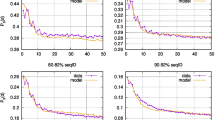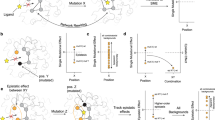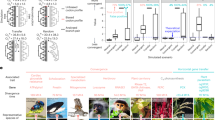Abstract
The main forces directing long-term molecular evolution remain obscure. A sizable fraction of amino-acid substitutions seem to be fixed by positive selection1,2,3,4, but it is unclear to what degree long-term protein evolution is constrained by epistasis, that is, instances when substitutions that are accepted in one genotype are deleterious in another. Here we obtain a quantitative estimate of the prevalence of epistasis in long-term protein evolution by relating data on amino-acid usage in 14 organelle proteins and 2 nuclear-encoded proteins to their rates of short-term evolution. We studied multiple alignments of at least 1,000 orthologues for each of these 16 proteins from species from a diverse phylogenetic background and found that an average site contained approximately eight different amino acids. Thus, without epistasis an average site should accept two-fifths of all possible amino acids, and the average rate of amino-acid substitutions should therefore be about three-fifths lower than the rate of neutral evolution. However, we found that the measured rate of amino-acid substitution in recent evolution is 20 times lower than the rate of neutral evolution and an order of magnitude lower than that expected in the absence of epistasis. These data indicate that epistasis is pervasive throughout protein evolution: about 90 per cent of all amino-acid substitutions have a neutral or beneficial impact only in the genetic backgrounds in which they occur, and must therefore be deleterious in a different background of other species. Our findings show that most amino-acid substitutions have different fitness effects in different species and that epistasis provides the primary conceptual framework to describe the tempo and mode of long-term protein evolution.
This is a preview of subscription content, access via your institution
Access options
Subscribe to this journal
Receive 51 print issues and online access
$199.00 per year
only $3.90 per issue
Buy this article
- Purchase on Springer Link
- Instant access to full article PDF
Prices may be subject to local taxes which are calculated during checkout
Similar content being viewed by others
References
McDonald, J. H. & Kreitman, M. Adaptive protein evolution at the Adh locus in Drosophila. Nature 351, 652–654 (1991)
Andolfatto, P. Adaptive evolution of non-coding DNA in Drosophila. Nature 437, 1149–1152 (2005)
Charlesworth, J. & Eyre-Walker, A. The rate of adaptive evolution in enteric bacteria. Mol. Biol. Evol. 23, 1348–1356 (2006)
Boyko, A. R. et al. Assessing the evolutionary impact of amino acid mutations in the human genome. PLoS Genet. 4, e1000083 (2008)
Kimura, M. Evolutionary rate at the molecular level. Nature 217, 624–626 (1968)
Li, W. H. Molecular Evolution 419–429 (Sinauer, 1997)
Kimura, M. The role of compensatory neutral mutations in molecular evolution. J. Genet. 64, 7–19 (1985)
Weinreich, D. M., Watson, R. A. & Chao, L. Sign epistasis and genetic constraint on evolutionary trajectories. Evolution 59, 1165–1174 (2005)
Lehner, B. Molecular mechanisms of epistasis within and between genes. Trends Genet. 27, 323–331 (2011)
de Visser, J. A., Cooper, T. F. & Elena, S. F. The causes of epistasis. Proc. R. Soc. Lond. B 278, 3617–3624 (2011)
Kondrashov, A. S., Sunyaev, S. & Kondrashov, F. A. Dobzhansky-Muller incompatibilities in protein evolution. Proc. Natl Acad. Sci. USA 99, 14878–14883 (2002)
Maynard Smith, J. Natural selection and the concept of a protein space. Nature 225, 563–564 (1970)
Fitch, W. M. & Markowitz, E. An improved method for determining codon variability in a gene and its application to the rate of fixation of mutations in evolution. Biochem. Genet. 4, 579–593 (1970)
Gillespie, J. H. Natural selection and the molecular clock. Mol. Biol. Evol. 3, 138–155 (1986)
Povolotskaya, I. S. & Kondrashov, F. A. Sequence space and the ongoing expansion of the protein universe. Nature 465, 922–926 (2010)
Poon, A. F. & Chao, L. Functional origins of fitness effect-sizes of compensatory mutations in the DNA bacteriophage phiX174. Evolution 60, 2032–2043 (2006)
Bridgham, J. T., Ortlund, E. A. & Thornton, J. W. An epistatic ratchet constrains the direction of glucocorticoid receptor evolution. Nature 461, 515–519 (2009)
Meer, M. V., Kondrashov, A. S., Artzy-Randrup, Y. & Kondrashov, F. A. Compensatory evolution in mitochondrial tRNAs navigates valleys of low fitness. Nature 464, 279–282 (2010)
Costanzo, M. S. & Hartl, D. L. The evolutionary landscape of antifolate resistance in Plasmodium falciparum. J. Genet. 90, 187–190 (2011)
Salverda, M. L. et al. Initial mutations direct alternative pathways of protein evolution. PLoS Genet. 7, e1001321 (2011)
Woods, R. J. et al. Second-order selection for evolvability in a large Escherichia coli population. Science 331, 1433–1436 (2011)
Osada, N. & Akashi, H. Mitochondrial-nuclear interactions and accelerated compensatory evolution: evidence from the primate cytochrome C oxidase complex. Mol. Biol. Evol. 29, 337–346 (2012)
Kvitek, D. J. & Sherlock, G. Reciprocal sign epistasis between frequently experimentally evolved adaptive mutations causes a rugged fitness landscape. PLoS Genet. 7, e1002056 (2011)
Silva, R. F. et al. Pervasive sign epistasis between conjugative plasmids and drug-resistance chromosomal mutations. PLoS Genet. 7, e1002181 (2011)
Notredame, C., Higgins, D. G. & Heringa, J. T-Coffee: a novel method for fast and accurate multiple sequence alignment. J. Mol. Biol. 302, 205–217 (2000)
Lunzer, M., Golding, G. B. & Dean, A. M. Pervasive cryptic epistasis in molecular evolution. PLoS Genet. 6, e1001162 (2010)
Costanzo, M. et al. The genetic landscape of a cell. Science 327, 425–431 (2010)
Tokuriki, N. & Tawfik, D. S. Chaperonin overexpression promotes genetic variation and enzyme evolution. Nature 459, 668–673 (2009)
Poelwijk, F. J., de Vos, M. G. & Tans, S. J. Tradeoffs and optimality in the evolution of gene regulation. Cell 146, 462–470 (2011)
Burga, A. Olivia Casanueva, M. & Lehner, B. Predicting mutation outcome from early stochastic variation in genetic interaction partners. Nature 480, 250–253 (2011)
Benson, D. A., Karsch-Mizrachi, I., Lipman, D. J., Ostell, J. & Wheeler, D. L. GenBank. Nucleic Acids Res. 34, D16–D20 (2006)
Tatusov, R. L., Koonin, E. V. & Lipman, D. J. A genomic perspective on protein families. Science 278, 631–637 (1997)
Katoh, K., Misawa, K., Kuma, K. & Miyata, T. MAFFT: a novel method for rapid multiple sequence alignment based on fast Fourier transform. Nucleic Acids Res. 30, 3059–3066 (2002)
Sievers, F. et al. Fast, scalable generation of high-quality protein multiple sequence alignments using Clustal Omega. Mol. Syst. Biol. 7, 539 (2011)
Nei, M. & Li, W. H. Mathematical model for studying genetic variation in terms of restriction endonucleases. Proc. Natl Acad. Sci. USA 76, 5269–5273 (1979)
Sayers, E. W. et al. Database resources of the National Center for Biotechnology Information. Nucleic Acids Res. 40, D13–D25 (2012)
Sunyaev, S. et al. Prediction of deleterious human alleles. Hum. Mol. Genet. 10, 591–597 (2001)
Yang, Z. PAML 4: phylogenetic analysis by maximum likelihood. Mol. Biol. Evol. 24, 1586–1591 (2007)
Acknowledgements
The work was supported by Plan Nacional grants from the Spanish Ministry of Science and Innovation, to F.A.K. and C.N. C.K. was supported by the European Union FP7 project Quantomics (KBBE2A222664). F.A.K. is a European Molecular Biology Organization Young Investigator and Howard Hughes Medical Institute International Early Career Scientist. We thank B. Lehner and T. Warnecke for input and a critical reading of the manuscript.
Author information
Authors and Affiliations
Contributions
M.S.B., C.K., P.K.V. and F.A.K. participated in obtaining and quality-testing the data; C.K. and C.N. participated in the design of the alignment algorithm; and F.A.K. designed the study and wrote the manuscript with the participation of all authors.
Corresponding author
Ethics declarations
Competing interests
The authors declare no competing financial interests.
Supplementary information
Supplementary Information
This file contains Supplementary Tables 1-6 and Supplementary Figures 1-4. (PDF 698 kb)
Rights and permissions
About this article
Cite this article
Breen, M., Kemena, C., Vlasov, P. et al. Epistasis as the primary factor in molecular evolution. Nature 490, 535–538 (2012). https://doi.org/10.1038/nature11510
Received:
Accepted:
Published:
Issue Date:
DOI: https://doi.org/10.1038/nature11510
This article is cited by
-
Designed active-site library reveals thousands of functional GFP variants
Nature Communications (2023)
-
Stability and expression of SARS-CoV-2 spike-protein mutations
Molecular and Cellular Biochemistry (2023)
-
Protein folding rate evolution upon mutations
Biophysical Reviews (2023)
-
Therapeutic enzyme engineering using a generative neural network
Scientific Reports (2022)
-
Deciphering polymorphism in 61,157 Escherichia coli genomes via epistatic sequence landscapes
Nature Communications (2022)
Comments
By submitting a comment you agree to abide by our Terms and Community Guidelines. If you find something abusive or that does not comply with our terms or guidelines please flag it as inappropriate.



